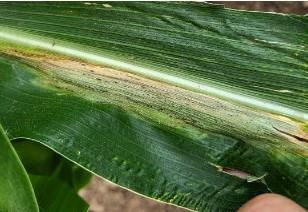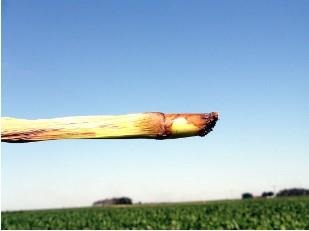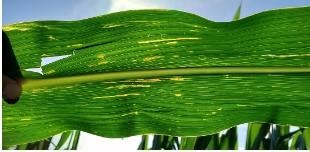By Amy Timmerman
Several diseases have been reported and/or confirmed in corn samples across the state. Severe weather conditions including hail and wind have caused plant injury, which has provided an opportunity for pathogens to invade. Producers and consultants should monitor the severity of these diseases and others, as well as their potential to impact yield to assess the need for treatment or other risks later in the season.
Bacterial Diseases
Bacterial diseases in corn have been confirmed in fields that received wounds either from hail and/or sandblasting. Goss’s bacterial wilt and blight, bacterial stalk rot and bacterial leaf streak have been confirmed. Current warm temperatures, rainfall/overhead irrigation, and wind will support spread and further development of these diseases.

Figure 1. Goss’s bacterial wilt and blight lesions may include dark green to black “freckles".
Goss's Bacterial Wilt and Blight
Goss’s bacterial wilt and blight is identified by looking for two key features on the leaves. The first feature is dark green/black “freckles” or flecks on the edges of dark, water-soaked lesions (Figure 1). Freckles may appear translucent when backlit by bright light such as the sun. The second feature of the disease is the presence of bacterial exudate, often called “ooze”, which occurs when the bacteria is secreted on the surface of the lesion. Once the ooze is dried, it will give the leaf a shiny or sparkling appearance. Be sure to check the bottom side of the leaf carefully as well, as the ooze may be washed away by rainfall or overhead irrigation.

Figure 2. Bacterial stalk rot may develop in the bottom of plants standing in water or in the tops of plants, rotting out several nodes that can be easily removed (pictured). Affected plant parts often have a foul odor.
Bacterial Stalk Rot
Bacterial stalk rot, caused by Erwinia dissolvens or E. chrysanthemi, survives in corn and sorghum residue. Symptoms start as lesion development on the lower stalk or discoloration of a leaf sheath and then systematically move up the stalk and throughout the plant. A foul “fishy” odor is common and the top of the plant can often be easily removed (Figure 2). As the disease progresses, the stalk may rot and the plant can collapse. Bacterial stalk rot can affect the plant at any node and when infection occurs high on the plant it may impair normal tasseling. When stalks are split, there is internal discoloration and soft slimy rot present mostly at the nodes that may hollow out stalks.

Figure 3. Bacterial leaf streak lesions have irregular margins and may appear yellow when backlit by the sun.
Bacterial Leaf Streak
Bacterial leaf streak symptoms are interveinal leaf streaks that are brown, tan or yellow, which can be short or very long (Figure 3). Lesions are often strikingly yellow when backlit against the sun. A key characteristic to look for is the wavy, jagged margins of the lesion, which can be used to differentiate them from the smooth, rectangular lesions of gray leaf spot.
Unfortunately, fungicides are ineffective against bacterial pathogens, making accurate diagnoses important. Some bactericides are labeled for use on corn, but their use has had inconsistent results on these diseases.

Figure 4. Common smut galls may develop on any plant part. When present on the leaves, they are often smaller and may have a warty appearance (pictured).
Fungal Diseases
Common Smut
Common smut occurs in almost every field of corn in Nebraska but is more prevalent in fields after plants are injured. This fungal disease is caused by the fungus Ustilago maydis and can also be called “boil smut.” Smut galls may look like mushrooms or warts and can develop on any plant part, including leaves (Figure 4), stalks and tassels, but is most recognizable when they develop on the ear, replacing kernels. Initially, galls are white to gray in color and fleshy to the touch. As the gall matures, it ruptures, releasing a large amount of black teliospores that will overwinter in the soil for future years.
Fungicides are not effective for managing common smut. Some sweet corn varieties are less susceptible to the disease and may be selected to reduce disease pressure.
Source : unl.edu